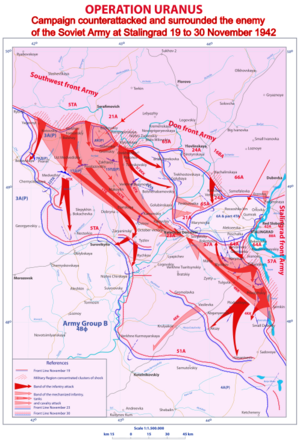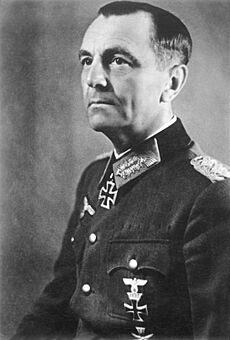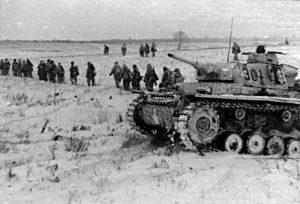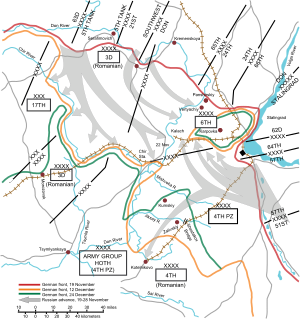Operation Uranus facts for kids
Quick facts for kids Operation Uranus |
|||||||||
|---|---|---|---|---|---|---|---|---|---|
| Part of the Battle of Stalingrad | |||||||||
 |
|||||||||
|
|||||||||
| Belligerents | |||||||||
| Commanders and leaders | |||||||||
| Strength | |||||||||
| 1,143,500 personnel (including reserve) 894 tanks 13,451 artillery pieces 1,500 aircraft |
German: 400,000 personnel (6th Army and 4th Panzer Army) unknown number of artillery pieces 732 aircraft (402 serviceable) Italian: unknown number of artillery pieces or aircraft Romanian: 143,296–200,000 personnel 827 artillery pieces 134 tanks unknown number of aircraft |
||||||||
| Casualties and losses | |||||||||
| Unknown | Unknown, presumed heavy | ||||||||
Operation Uranus was a major military plan by the Soviet Union during World War II. It took place from November 19 to 23, 1942, on the Eastern Front. This operation led to the surrounding of Axis forces, including the German Sixth Army, near the city of Stalingrad.
The Red Army launched Operation Uranus in the middle of the five-month-long Battle of Stalingrad. Their main goal was to trap and destroy the German forces fighting in and around Stalingrad. Planning for this important operation began in September 1942.
The German and other Axis forces were spread out too much because of their summer attacks in 1942. These attacks aimed to capture oil fields and Stalingrad. Germany also moved some of its powerful tank divisions from the Soviet Union to Western Europe. This made their situation even worse.
Axis units in the Stalingrad area were also very tired from months of fighting. The Romanian armies, who were guarding the German Sixth Army's sides, lacked strong equipment. They couldn't stand up to Soviet tanks. In contrast, the Red Army gathered over a million soldiers for this attack.
The Soviet forces faced some challenges, like keeping their troop movements secret. Also, some units arrived late due to problems with supplies. Operation Uranus was delayed twice before finally starting on November 19.
On November 19, Soviet forces attacked the northern side of the Axis lines. Attacks in the south began the next day. The Romanian units tried to fight back but were soon forced to retreat. The Red Army's fast-moving tank units bypassed several German infantry divisions.
German mobile reserves were too weak to stop the Soviet attack. The German Sixth Army did not react quickly enough to move its tanks from Stalingrad to fight the new threat. By November 22, the Soviet forces from the north and south met near the town of Kalach. This trapped about 290,000 Axis soldiers east of the Don River.
Instead of trying to break out, German leader Adolf Hitler ordered his forces to stay in Stalingrad. He planned to send them supplies by air.
Contents
Why the Battle Happened
German Summer Offensive
On June 28, 1942, the German army, called the Wehrmacht, started a big attack. This attack was named Case Blue. It aimed to capture the city of Rostov and then move towards the Volga River. After taking Rostov, Hitler decided to split his forces. One group would try to capture Stalingrad, and the other would go for the Caucasus oil fields.
The Sixth Army was given the job of taking Stalingrad. They moved towards the Volga River with strong air support from the German air force, the Luftwaffe. By August 22, German forces began crossing the Don River. The next day, the Battle of Stalingrad officially started as German troops reached the city's edge.
Stretched German Lines
By November, the German Sixth Army had taken most of Stalingrad. They had pushed the Soviet defenders back to the Volga River. But there were signs that the Soviets were planning a big counterattack. Soviet activity increased on the sides of the German Sixth Army. Also, captured Soviet soldiers gave information about a coming attack.
The German commanders were focused on taking Stalingrad. They weren't sure where or when the Soviet counterattack would happen. Germany ordered some tank and infantry divisions to Russia from France. But these units wouldn't arrive until December. A German general, Franz Halder, was even fired in September. He had tried to warn about the danger of the German lines being too stretched out.
Soviet Plans for Counterattack
In September, the Soviet high command, called Stavka, started planning several counterattacks. These plans aimed to destroy German forces in the south, including those fighting in Stalingrad and the Caucasus. They also planned an attack against the German Army Group Center further north. General Aleksandr Vasilevsky was put in charge of the Soviet efforts around Stalingrad.
The Stavka developed two main operations for the Stalingrad area: Uranus and Saturn. They also planned Operation Mars to attack German Army Group Center. This was meant to stop Germany from sending more troops to the south. Operation Uranus involved many Soviet tanks and infantry. Their goal was to surround the German and other Axis forces directly around Stalingrad.
The Soviets carefully chose the starting points for their attack. These points were behind the German Sixth Army's main lines. This made it hard for the Germans to quickly send help to those areas. The attack was a double envelopment. This means Soviet tank forces would push deep into the German rear. Another attack would happen closer to the German Sixth Army. This would trap German units from both sides.
While the Red Army got ready, German commanders didn't believe a big Soviet attack was coming in the south. They thought the Soviets were only building up forces against Army Group Center in the north.
Comparing the Armies
Axis Forces
The German summer offensive, Case Blue, spread German and other Axis forces very thinly. Their front line was over 480 kilometers (300 miles) wide and hundreds of kilometers deep. The decision to capture Stalingrad made this problem even worse. For example, in early July, the German Sixth Army had to defend a 160-kilometer (100-mile) line. At the same time, they were attacking over a distance of about 400 kilometers (250 miles).
The German Army Group B, which included the forces around Stalingrad, looked strong on paper. It had German, Romanian, Italian, and Hungarian armies. But it had very few reserves. Most of the German forces were busy fighting in Stalingrad or the Caucasus. The sides of the German lines were mostly held by non-German Axis armies.

Adolf Hitler trusted these non-German Axis units to protect the German sides. But in reality, these units had old equipment. Their artillery was often pulled by horses. Also, officers sometimes treated their soldiers badly, which lowered morale. For example, the First Romanian Armored Division had about 100 Czech-built R-2 tanks. Their 37mm guns were not strong enough to damage Soviet T-34 tanks. Their 37mm anti-tank guns were also old and they didn't have much ammunition. The Germans only sent them a few better 75mm guns after many requests.
These units were also spread out over very long front lines. The Third Romanian Army held a 140-kilometer (87-mile) line. The Fourth Romanian Army protected a line at least 270 kilometers (168 miles) long.
German forces were also in bad shape. They were tired from months of fighting. While the Soviets formed new armies, Germany struggled to keep its existing tank units strong. Also, two important German motorized divisions were moved from Russia to France. This was to prepare for a possible Allied landing in France. The Sixth Army had also lost many soldiers fighting inside Stalingrad. Some German tank divisions, like the 22nd Panzer Division, had equipment no better than the Romanians. German units were also spread out. For example, one German corps had to defend a line about 100 kilometers (62 miles) long.
Soviet Forces
The Red Army gathered about 1,100,000 soldiers for the attack. They also had 804 tanks, 13,400 artillery pieces, and over 1,000 aircraft. Against the Third Romanian Army, the Soviets placed their 5th Tank Army, along with the 21st and 65th Armies. These forces would break through the German sides.
The German southern side was attacked by the Stalingrad Front's 51st and 57th Armies. These armies had the 13th and 4th Mechanized Corps. Their goal was to break through the Fourth Romanian Army. Then, they would meet the 5th Tank Army near Kalach. In total, the Soviets had 11 armies and many independent tank brigades ready.
Getting ready for the attack was not easy. On November 8, the Stavka had to delay the start date. This was because many units were late moving into position. Meanwhile, units at the front practiced fighting enemy counterattacks. They also practiced using tanks to break through enemy lines.
The Soviets used clever tricks to hide their preparations. They reduced radio traffic and used camouflage. They also used messengers instead of radios to communicate. They even built fake bridges to distract the Germans from the real bridges being built across the Don River. The Red Army also increased attacks against Army Group Center in the north. This made the Germans think the main Soviet attack would be there.
Soviet forces near Stalingrad faced heavy bombing, which made it harder to move troops. Engineer battalions had to transport ammunition, soldiers, and tanks across the Volga River. They also scouted the areas where the attack would happen. In three weeks, the Red Army moved about 111,000 soldiers, 420 tanks, and 556 artillery pieces across the Volga.
On November 17, General Vasilevsky was called back to Moscow. He saw a letter from General Vasily Volsky, who commanded the 4th Mechanized Corps. Volsky wanted to cancel the attack. He thought the plan would fail because the forces were not ready. Many Soviet soldiers didn't have winter clothes and suffered from frostbite. Vasilevsky also wanted to cancel the attack. But the other Soviet commanders disagreed. They decided the attack would go ahead. Stalin himself called Volsky, who agreed to carry out the operation as ordered.
The Soviet Attack Begins
Operation Uranus was delayed again until November 19. This was because Soviet General Georgy Zhukov said the air units were not ready.
Northern Front Attack: November 19
On November 19, at 7:20 AM Moscow time, Soviet artillery commanders received the signal "Siren." This started an 80-minute artillery bombardment. It was aimed mostly at the non-German Axis units protecting the German sides. At 7:30 AM, Katyusha rocket launchers fired their first rockets. Soon, 3,500 guns and mortars joined in. They fired along the breakthrough areas in front of the Third Romanian Army.
Even though thick fog made it hard to see, the Soviet artillery was very accurate. This was because of weeks of careful preparation. The bombardment was devastating. Communication lines were cut, ammunition dumps were destroyed, and observation posts were shattered. Many Romanian soldiers who survived the shelling started to run away. Soviet heavy artillery also hit Romanian artillery positions and retreating soldiers.
The attack against the Third Romanian Army began at 8:50 AM. It was led by the 21st and 65th Soviet Armies and the 5th Tank Army. The first two Soviet attacks were pushed back by the Romanians. The heavy shelling had even made it harder for Soviet tanks to move through minefields. However, the Romanians didn't have enough strong anti-tank artillery. Their defense soon collapsed. By noon, the 4th Tank Corps and 3rd Guards Cavalry Corps had broken through. Soon after, the 5th Tank Army also broke through the Second Romanian Corps.
As Soviet tanks moved through the thick fog, they overran Romanian and German artillery positions. Three Romanian infantry divisions began to fall apart. The Third Romanian Army was now surrounded from the west and east. The German Sixth Army headquarters heard about the Soviet attack. But they failed to order their 16th and 24th Panzer Divisions, which were fighting in Stalingrad, to help the Romanians. Instead, they sent the very weak and poorly equipped 48th Panzer Corps.
The 48th Panzer Corps had fewer than 100 working modern tanks. They also lacked fuel. The shortage of tanks forced commanders to use tank crews as infantry. The 22nd Panzer Division, part of this corps, was almost completely destroyed. It started with fewer than thirty working tanks and ended with only a company of tanks. The Romanian 1st Armored Division, which was with the 48th Panzer Corps, fought the Soviet 26th Tank Corps and was defeated by November 20. As the Soviets kept moving south, many Soviet tank crews suffered from a bad blizzard. This affected both soldiers and equipment. It also blocked gun sights. Tanks often lost grip, and crew members sometimes broke their arms from being thrown around inside. However, the blizzard also made it hard for the German corps to coordinate their actions.
By the end of November 19, the Third Romanian Army was in full retreat. The Soviet 21st Army and 5th Tank Army captured 27,000 Romanians. They then continued their advance south. Soviet cavalry was used to take advantage of the breakthrough. They cut communications between the Romanians and the Italian 8th Army. They also blocked any counterattack against the Soviet side. The Soviet air force attacked retreating Romanian soldiers, while the Luftwaffe offered very little help. The retreat of the 1st Romanian Cavalry Division allowed the 65th Army to get around German defenses. As German forces started to react late on November 19, another Soviet attack began on the Sixth Army's southern side.
Southern Front Attack: November 20
On the morning of November 20, the Stavka asked Stalingrad Front commander Andrei Yeremenko if he would start his part of the attack on time, at 8:00 AM. He said he would, but only if the fog lifted. The 51st Army started its artillery barrage on time because headquarters couldn't reach them. But the rest of the forces were told to delay their attack until 10:00 AM. The 51st Army fought the Romanian 6th Corps and took many prisoners. When the 57th Army joined the attack at 10:00 AM, the Stalingrad Front was able to send its tank corps into battle. The German 297th Infantry Division watched as its Romanian support failed to fight back against the Red Army. However, confusion and lack of control caused the Soviet 4th and 13th Mechanized Corps to struggle as they tried to push through the breakthroughs.
The Germans quickly responded by moving their only reserve in the area, the 29th Panzergrenadier Division. This division had some early successes against Soviet tanks. But the Romanian collapse forced them to move again to try and strengthen defenses to the south. The 29th Panzergrenadier Division's counterattack destroyed about fifty Soviet tanks. This made Soviet commanders worry about their left side. However, the German division's move meant that by the end of the day, only the 6th Romanian Cavalry Regiment stood between the advancing Soviet forces and the Don River.
Continuing the Encirclement: November 20–23
While the Stalingrad Front attacked on November 20, the 65th Soviet Army kept pushing the German 11th Corps on the northern side of the Sixth Army. The Red Army's 4th Tank Corps advanced past the German 11th Corps. The 3rd Guards Cavalry Corps then attacked the German unit from behind. The German 376th Infantry Division and the Austrian 44th Infantry Division started to move to face the enemy on their sides. But they were slowed down by a lack of fuel. The 14th Panzer Division's tank regiment destroyed a Soviet cavalry regiment. But its anti-tank artillery suffered heavy losses when Soviet forces overran it. By the end of the day, the Soviet 1st Tank Corps was chasing the retreating 48th Panzer Corps. The Soviet 26th Tank Corps had captured the town of Perelazovsky, almost 130 kilometers (81 miles) northwest of Stalingrad.
The Red Army's attack continued on November 21. Forces from the Stalingrad Front advanced up to 50 kilometers (31 miles). By this time, the remaining Romanian units in the north were being destroyed. The Red Army also began to attack the sides of the German Fourth Panzer and Sixth Armies. The German 22nd Panzer Division tried a small counterattack. But it was reduced to just a tank company and forced to retreat. The Soviet 26th Tank Corps, after destroying much of the Romanian 1st Armored Division, continued its advance. It avoided fighting enemy units left behind. However, parts of the Romanian 5th Corps managed to regroup and set up a quick defense.
That day, German General Friedrich Paulus, commander of the Sixth Army, received reports. The Soviets were less than 40 kilometers (25 miles) from his headquarters. Also, there were no units left to stop the Soviet advance. In the south, after a short stop, the Soviet 4th Mechanized Corps continued moving north. It removed German defenders from several towns and headed towards Stalingrad.
As German forces in and around Stalingrad were in danger, Hitler gave an order. He told them to set up an "all-around defensive position." He called the forces between the Don and Volga rivers "Fortress Stalingrad." He did not allow the Sixth Army to try and break out. The Sixth Army, other Axis units, and most of the Fourth Panzer Army's German units were caught inside the growing Soviet encirclement. Only the 16th Panzergrenadier Division began to fight its way out. A lack of coordination between Soviet tanks and infantry on the German southern side allowed much of the Fourth Romanian Army to escape.
On November 22, Soviet forces began to cross the Don River. They continued their advance towards the town of Kalach-on-the-Don. German forces defending Kalach, mostly maintenance and supply staff, didn't know about the Soviet attack until November 21. Even then, they didn't know how strong the Red Army was. The Soviet 26th Tank Corps was given the job of taking the bridge at Kalach. They used two captured German tanks and a scout vehicle to approach it and fire on the guards. Soviet forces broke into the town by mid-morning and drove out the defenders. This allowed them and the 4th Tank Corps to link up with the Red Army's 4th Mechanized Corps coming from the south. The encirclement of German forces in Stalingrad was completed on November 22, 1942. That day, Soviet units also continued to fight pockets of Romanian resistance.
The encirclement of the German 6th Army was complete on November 23. Around 4:00 PM, near the village of Sovetsky, Soviet tanks from the 4th Mechanized Corps met tanks from the 4th Tank Corps. At first, they thought they were Germans because they didn't fire green flares as a signal. Several tanks were damaged in a short exchange of fire. After they realized they were friendly forces, they linked up. This event was later re-enacted for newsreels.
The meeting of these Soviet tank forces completed the surrounding of General Paulus's group of forces. This included two of the most powerful German armies, 22 divisions, and many other units. Never before in the war had so many German troops been trapped together. The Soviet high command first thought the trapped force was much smaller. This was because it included many extra personnel, like engineers and air force ground staff. Fighting continued on November 23 as the Germans tried to counterattack to break out, but failed. Axis soldiers inside the trap moved east towards Stalingrad to avoid Soviet tanks. Those who managed to escape moved west towards other German and Axis forces.
What Happened Next
Operation Uranus trapped between 250,000 and 300,000 Axis soldiers. They were caught in an area about 50 kilometers (31 miles) from east to west and 40 kilometers (25 miles) from north to south. This trapped group included four German infantry corps, a tank corps, parts of two Romanian divisions, and other special units. They also lost about 100 tanks, 2,000 artillery pieces, and 10,000 trucks.
As they retreated towards Stalingrad, the roads were covered with helmets, weapons, and other abandoned equipment. Heavy equipment that was destroyed was left on the side of the road. Bridges over the Don River were jammed with traffic. Surviving Axis soldiers rushed west in the cold weather. They tried to escape Soviet tanks and infantry that threatened to cut them off from Stalingrad. Many wounded Axis soldiers were trampled. Many who tried to cross the frozen river on foot fell through the ice and drowned. Hungry soldiers searched Russian villages for supplies. Supply dumps were often looted for food. The last stragglers crossed the Don River by November 24. They then destroyed the bridges to cut off the Fourth Panzer and Sixth Armies from the Soviets in Stalingrad.
The German Sixth Army, in the middle of chaos, began to build defensive lines. They had little fuel, ammunition, or food. The harsh Russian winter also made things harder. They also had to fill gaps in the line left by the breaking Romanian forces. On November 23, some German units destroyed or burned anything not needed for a breakout. They then started to pull back towards the northern part of Stalingrad. However, after the Germans left their winter bunkers, the Soviet 62nd Army was able to destroy the German 94th Infantry Division in the open. Survivors of this German division were added to the 16th and 24th Panzer Divisions.
German military commanders thought the trapped forces should try to break out. But between November 23 and 24, Hitler decided to hold the position. He planned to resupply the Sixth Army by air. The soldiers trapped in Stalingrad would need at least 680 tons of supplies every day. The German air force, the Luftwaffe, was too weak to do this. Also, the revived Red Air Force was a threat to German planes trying to fly over the trapped area. By December, the Luftwaffe had about 500 aircraft. But this was still not enough to supply the Sixth Army. In the first half of December, the Sixth Army received less than 20% of the supplies they needed daily.
Meanwhile, the Red Army strengthened its outer encirclement. Their goal was to destroy the trapped German units. Soviet armies would attack German units from the east and south. This would split the German forces into smaller groups. These orders became effective on November 24. The outer encirclement was about 320 kilometers (200 miles) long. However, only three-quarters of this distance was actually covered by Soviet troops. The distance between the outer and inner encirclements was about 16 kilometers (10 miles). The Soviet high command also began planning for Operation Saturn. This operation aimed to destroy the Italian Eighth Army and cut off German forces in the Caucasus. The Soviet Stavka planned for Saturn to start around December 10.
German forces in the area were further split up. German general Erich von Manstein was given command of the new Army Group Don. This group included the German Fourth Panzer and Sixth Armies, and the Third and Fourth Romanian Armies. Although the situation looked bad for the Germans, a period of calm followed Operation Uranus. Both German and Soviet forces were planning their next moves.
The moment when the Soviet forces linked up was not filmed at the time. It was later re-enacted for a propaganda film that was shown around the world.
See also
- Romanian armies in the Battle of Stalingrad
- Operation Little Saturn




